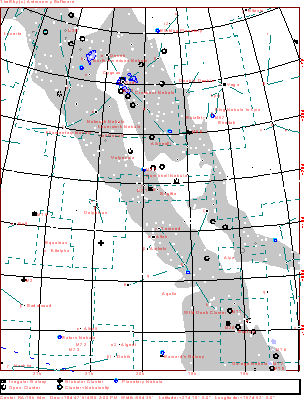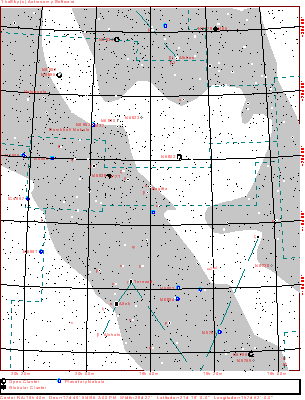This may be an arrow shot by Apollo to kill the Cyclops. Perhaps Hercules shot it at the Stymphalian birds. Perhaps he shot it at the eagle, or vulture that perpetually gnawed Prometheus' liver. Perhaps it is one of Cupid's arrows. Trace it backwards, and you find it comes from Hercules. Either way, it is an old constellation, and many cultures have seen an arrow in its five stars.
Each map can be clicked on to produce a 916x1200 version of it. They sport red labels, which look good on screen, but which disappear when used with red flashlights. Each map, therefore has a second link to a map better suited for printing in a graphics program, and using in the field. While they are quite large, they are all about 50k, and so are easy to view at today's modem speeds. The first map is a wide area view of the constellation, suitable for naked eye browsing. The next views are binocular width, showing stars to mag. 10, deepsky objects to mag. 12.9, and labeling deepsky objects to magnitude 12.
Interactive, wide area map of Sagitta

Click the map for a 916x1200 version of the above. Click here for a map better suited for use in the field.
Detailed Map

This a more detailed view of the constellation. The map displays stars to magnitude 10, and deepsky objects to magnitude 12. Click here for a map better suited for use in the field.
 32k JPEG M71 (NGC6838) is a mag. 8.3 globular cluster located between delta and gamma Sagittae. Dreyer describes it as very large (7'), very rich, and condensed. Stars range from mags. 11-16. A pretty globular in a very rich field. A one minute exposure by Pedro Ré with a HISYS22 on a C-14. For more information on M71, click here. 32k JPEG M71 (NGC6838) is a mag. 8.3 globular cluster located between delta and gamma Sagittae. Dreyer describes it as very large (7'), very rich, and condensed. Stars range from mags. 11-16. A pretty globular in a very rich field. A one minute exposure by Pedro Ré with a HISYS22 on a C-14. For more information on M71, click here.
|

If you have any questions about the Hawaiian Astronomical Society
please
(link requires javascript).




 32k JPEG M71 (NGC6838) is a mag. 8.3 globular cluster located between delta and gamma Sagittae. Dreyer describes it as very large (7'), very rich, and condensed. Stars range from mags. 11-16. A pretty globular in a very rich field. A one minute exposure by Pedro Ré with a HISYS22 on a C-14. For more information on M71, click here.
32k JPEG M71 (NGC6838) is a mag. 8.3 globular cluster located between delta and gamma Sagittae. Dreyer describes it as very large (7'), very rich, and condensed. Stars range from mags. 11-16. A pretty globular in a very rich field. A one minute exposure by Pedro Ré with a HISYS22 on a C-14. For more information on M71, click here.